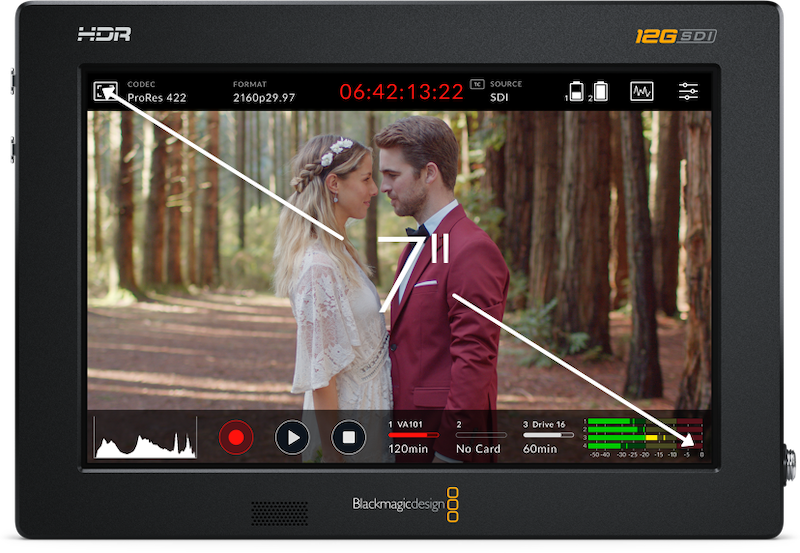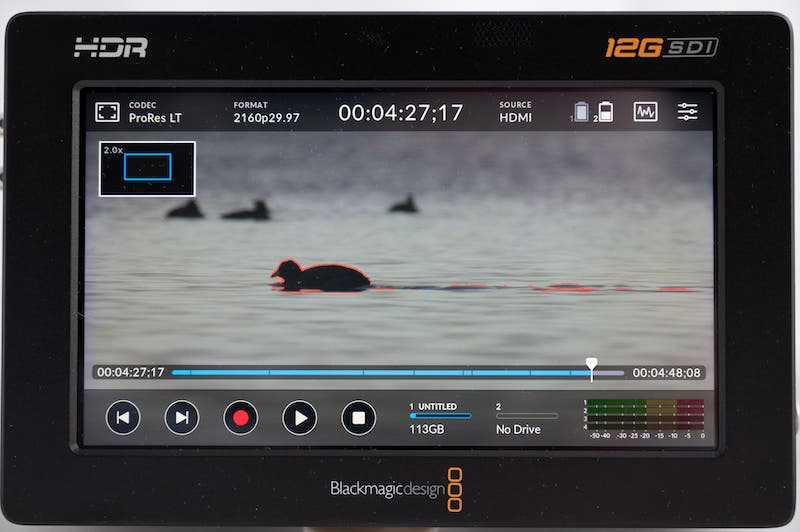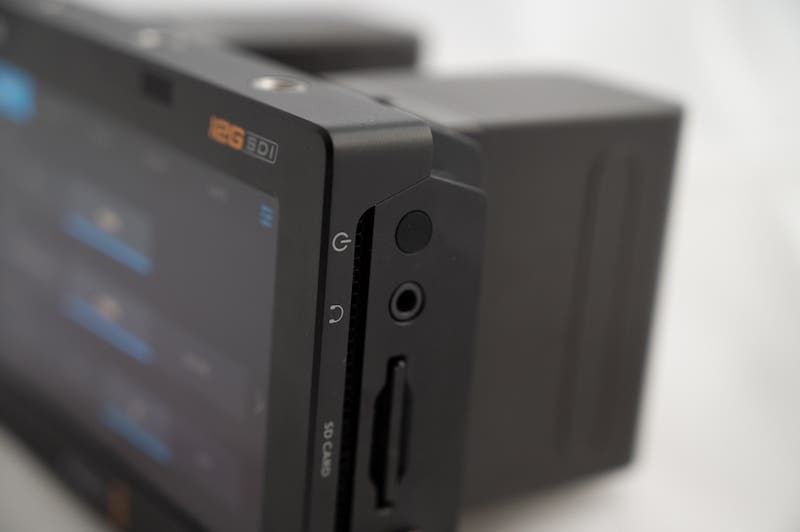An external monitor is an accessory you should consider when shooting videos with a DSLR camera. It is extremely uncomfortable and error-prone to film a scene while watching it through the built-in LCD screen. Oftentimes, you can’t properly see what is happening because of the size of the in-built LCD and reflections. Furthermore, recording in-camera has limitations that you can overcome with the right external monitor. However, not all external monitors are the same. I have been the lucky owner of a Blackmagic Design Video Assist 12G HDR Recording Monitor for some time now, and it has helped me upgrade the production value of my videos.

Key Features of the Blackmagic Video Assist:
I primarily use the Blackmagic Video Assist to record video tutorials about nature photography and record outdoor videos. By attaching this monitor to my camera, I can record all the on-screen information and demonstrate my photography techniques in camera changes I make to the menu settings. This gives a much more professional result than recording this using a second camera.
But the Blackmagic Video Assist is much more than a larger monitor and a way to record on-screen information from the camera. Consider all its key features to understand how a small piece of technology can improve your videography skills and help you produce professional videos.

Upgrade Your Recording Quality
It has up to 12G SDI and Ultra HD HDMI for fast connections, supporting video formats up to 4K (2160p60), making it a professional video recorder. If you buy a cheaper external monitor/recorder, you might not get support for recording externally in 4K even though your camera can record in 4K internally. This, plus the ability to record in a RAW video format — like Apple ProRes and Avid DNx — is a strong feature. I highly appreciate it since my cameras cannot record in ProRes without an upgrade from the manufacturer. Another thing I like is the ability to record beyond the 30 minutes supported by my DSLR camera.
For specific camera models, Blackmagic Video Assist provides support for RAW recording. It uses the proprietary Blackmagic RAW format to capture accurate color and detail that any professional photographer will love. Video Assist also records metadata to help you edit your footage.
For now, Blackmagic RAW supports the following camera models:
- Canon EOS C300 Mark II
- Fujifilm GFX 100 and GFX 100S
- Nikon Z6, Z7, Z6II, and Z7II
- Panasonic AU-EVA1
- Lumix DC-GH5s, BGH1, BS1H, DC-S1, DC-S1H, and DC-S5
- Sigma fp and fp L
You should check with your camera manufacturer whether support for Blackmagic RAW is a paid camera firmware upgrade.
5″ or 7″ HDR LCD Screen
Blackmagic Video Assist comes in two screen size options: 5″ and 7″. Of course, the larger the HDR touchscreen is, the better viewing experience you have. The 7″ version also comes with an additional slot for a second SD card. Because the Video Assist has three mounting points on the top and three on the bottom, you can mount it on almost any rig and transform it into a monitor for the entire filming team, instead of mounting it on top of your camera as most do.
You don’t have to worry about adding a lot of extra weight to your gear. The monitor is compact, light, and designed to be self-contained. It has an aluminum outer frame that is very durable, solid, and lightweight. Whether you choose the 5″ or the 7″ version, it will be easy to handhold the monitor or mount it to your camera without overloading the tripod.
If you’re looking for a new tripod, you can check out our list of Best Travel Tripods for Any Budget to pair with the Blackmagic Video Assist.

Brighter Touchscreen for Outdoor Shooting
Outdoor photographers and videographers will particularly like this feature. Blackmagic Video Assist has a super bright 2500nit touchscreen with a wide color gamut to help you shoot in bright sunlight. Many monitors market themselves as daylight viewable if they go to 1000 nits brightness. So with 2500 nits, this screen will show accurate colors even in the harshest sun. This helps you improve framing and composition, make sure exposure and focus settings are correct, and make adjustments while filming. You’ll also be able to see the controls and information displayed on the screen.
Enhanced Focus Assist
Blackmagic Video Assist allows you to change focus while shooting without disturbing your video setup. The screen displays information such as exposure histogram, focus zoom, focus peaking, false color, zebra, frame guides, frame markers, and more. I really enjoy the focus peaking feature because it allows you to change the width of the overlay that appears when the edges are in focus. This makes it easier to focus precisely.

Furthermore, you get to personalize the tools and features displayed on the touchscreen to have all you need on hand. The Video Assist overlays semi-transparent layers of information, allowing you to see the footage and data simultaneously.
Four Built-In HDR Scopes
Scenes with a high dynamic range need accurate exposure and compliance with broadcast standards. Blackmagic Video Assist provides real-time monitoring and allows you to visualize the image signal through waveforms, histograms, and vectorscopes. You can even overlay the signal analysis on top of your video and make informed decisions while shooting. It’s like having a video editor with you while recording the footage. I find that with Blackmagic Video Assist it is much easier to check that the video settings give you the correct exposure, accurate colors, and details.

Six Built-in 3D LUTs
Speaking of having a video editor on the shooting set, Blackmagic Video Assist provides six 3D LUTs to help you achieve the mood and look you want. It allows you to apply them on top of your video and have a peek at the finished product. Then, you can choose to burn them into the video files and use them in post-processing. I prefer not to burn them in but only to pre-visualize what the video will look like after post-processing.
If the built-in 3D LUTs aren’t enough, you should know that the Blackmagic Video Assist lets you load customized LUTs. It is an excellent feature for videographers looking for a specific style such as analog film, black and white, fantasy, dark, etc.
Slots for SD Cards and USB-C Flash Disks
When you start to record video footage outside the studio, you don’t want to be interrupted by ordinary events such as a full memory card or empty batteries. That’s why the Blackmagic Video Assist allows you to record on an SD card or USB-C flash disk.
The 5″ version has one slot for an SD card, while the 7″ version has two slots and starts recording automatically on the second one when the first one is full. In addition, both versions support recording to external USB-C flash disks. You can also connect the Blackmagic Video Assist to a computer and broadcast live videos.

Straightforward Interface and Build
The Blackmagic Video Assist is impressively easy to use and provides a straightforward interface that allows you to focus on the footage. All you have to do is swipe or tap, and settings appear on or disappear from the screen. The interface is intuitive, customizable, and user-friendly. I was genuinely impressed with the user interface, and it took me a very short time to get familiar with how it worked. Furthermore, you can mount the monitor upside-down or lock it at an unusual angle and still view the image correctly. Considering that you can attach the monitor on top of the camera or hang it from rigs, flexibility is a big plus.
Although it is light, the monitor is robust and durable. The aircraft-grade aluminum keeps it safe even in the harshest conditions. It also has intelligent battery management with two hot-swappable Sony L-Series batteries (not included) and can plug it into a universal 110V-240V AC power. You can carry it everywhere — either for photography or videography — without worrying that it won’t perform.
Why You Should Use It
The Blackmagic Design Video Assist is definitely an upgrade for better recording on many digital cameras. That option to record in RAW video format is truly valuable and gives you plenty of room to push the exposure and colors in post-processing.
It provides a generous and bright touchscreen for you to see the scene clearly and make informed decisions while recording even on the sunniest days. A screen brightness of 2500 nits is very impressive. It also provides all functionalities you may need on the field: tools to control the recording and playback of the footage, scopes to make sure everything works properly, focus assist settings, continuous recording on SD cards, and 3D LUTs to have an idea of the finished product. It has everything I could wish for in an external monitor.
What Could Be Improved
Although the Blackmagic Video Assist is a fantastic piece of equipment, I think there are still a couple of things that could be improved.
This includes the design of the power button. It is inclined, making it hard to find with your fingers, especially in low light. Of course, you get used to it in time but it would be nice to be a little bit more accessible.

I also feel that a mounting option for an external USB-C hard drive would be a nice touch. As it is, you need to cash up for a separate rig mounting solution for the external hard drive. Yes, there are slots for SD cards and a flash disk, but having the option to mount an external hard drive would be very welcome.
Concluding Words
If you are considering videography, the Blackmagic Design Video Assist 12G HDR External Monitor is an excellent addition to a video setup. It is versatile, smart, and durable. It goes equally well from filming video tutorials to recording documentaries, corporate videos, and short films. You won’t need too much time to learn to use it, and it will take your video production to the next level.






